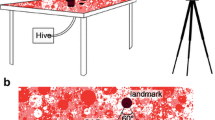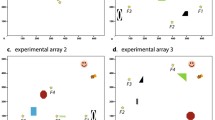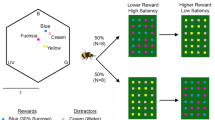Summary
During shape discrimination experiments bees are seen to fly slowly around in front of a shape before landing. The significance of this behaviour was investigated by recording flight paths (Figs. 1, 5) and landing patterns during choice experiments. The analysis consisted of two steps.
-
1.
To show that changing the shape changes the flight path of the bee in a related way (Figs. 2, 3):
-
a.
the overall pattern of flight traces out the form of the shape,
-
b.
the bee tends to fly to novel areas of a shape directly,
-
c.
the bee spends an increased amount of time flying directly in front of novel areas.
-
2.
To show that different flight paths to the same shape are reliably associated with different frequencies of choosing the shape. Flight paths were divided into categories and it was demonstrated that the bees frequency of landing is related to the area of the shape it flies across, bees encountering novel areas having an altered frequency of landing (Table 1). This change results from a changed frequency in the novel area itself coupled with a tendency to fly away from the shape directly from these changed areas rather than going on to investigate other parts of the shape (Fig. 4).
In addition it was noted that the entrance hole is an important locus, overall most flights passing to this region wherever they begin and many landings being recorded here.
As bees fly to novel areas of a shape directly and the subsequent flight in front of them affects the choice frequency, the flight may be regarded as a visual exploration or “scanning” of the shape and one part of a sequence of behaviours in which assessment of shape similarity is made. It is discussed how, for different shapes, different parts of this sequence may be of different importance in determining the overall choice frequency.
Similar content being viewed by others
Abbreviations
- l/b :
-
Landing per bee
References
Anderson, A.M.: Shape perception in the honey bee. Anim. Behav.25, 67–79 (1977a)
Anderson, A.M.: Parameters determining the attractiveness of stripe patterns in the honey bee. Anim. Behav.25, 80–87 (1977b)
Anderson, A.M.: The influence of pointed regions on the shape preference of honey bees. Anim. Behav.25, 88–94 (1977c)
Antes, J.R.: The time course of picture viewing. J. Exp. Psychol.103, 62–70 (1974)
Locher, P.J., Nodine, C.F.: The role of scanpaths in the recognition of random shapes. Percept. Psychophys.16, 308–314 (1974)
Noton, D.A.A.: A theory of visual pattern perception. IEEE Transactions on Systems Science and Cybernetics6, 349–357 (1970)
Wehner, R.: Pattern recognition in bees. Nature (Lond)215, 1244–1248 (1967)
Wehner, R.: Pattern recognition. In: The compound eye and vision of insects. Horridge, G. (ed.), pp. 75–113. London: Oxford University Press 1975
Wehner, R., Flatt, I.: Visual fixation in freely flying bees. Z. Naturforsch.32, 469–471 (1977)
Yarbus, A.L.: Eye movements and vision. New York: Plenum Press 1967
Zaporozhets, A.: Some of the psychological problems of sensory training in early childhood and the preschool period. In: A handbook of contemporary Soviet psychology. Cole, M., Maltzmann, I. (eds.). New York: Basic Books 1968
Author information
Authors and Affiliations
Additional information
I am very thankful to Professor T. Hidaka for providing space in his laboratory in Kyoto University and to the Royal Society for providing funds for my visit to Japan.
Rights and permissions
About this article
Cite this article
Anderson, A.M. Visual scanning in the honey bee. J. Comp. Physiol. 130, 173–182 (1979). https://doi.org/10.1007/BF00611051
Accepted:
Issue Date:
DOI: https://doi.org/10.1007/BF00611051




